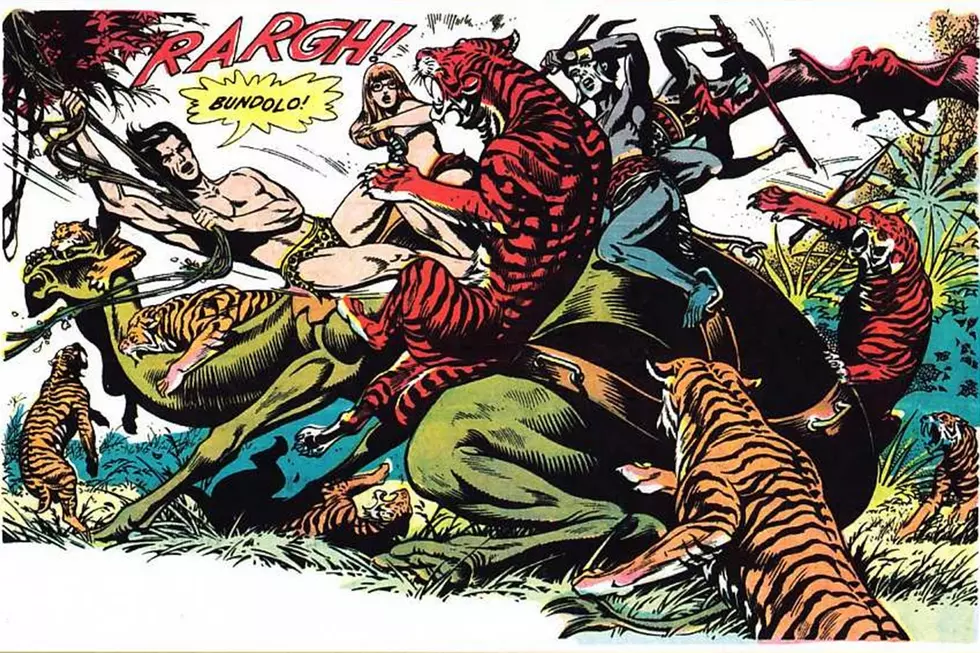
Key To The Universe: A Guide To The Heroes Of Gold Key Comics
Thanks to their respective billion dollar movie franchises, people everywhere are familiar with the superhero universes of Marvel and DC. But the Golden and Silver Ages of comics were boom periods for the superhero genre, with dozens of publishers trying their hands at the hot new genre, including Gold Key Comics.
The heroes of Gold Key never quite gained a permanent foothold in pop culture consciousness, but they've proved surprisingly resilient, and they're about to be reintroduced once again via Dynamite Entertainment's new series The Sovereigns as well as the recently announced new Magnus series. Here's everything you need to know about the history of the Gold Key heroes. You can also explore a visual history of Gold Key in the gallery above.
WHAT WAS GOLD KEY?
Gold Key Comics came into being in 1962, when its parent company Western Publishing decided to publish its own comics in-house. Previously, Western had an agreement with Dell Comics, whereby Western would produce comics and Dell would finance and distribute them.
Like Dell before them, Gold Key produced a large number of licensed comics based on popular TV shows and cartoons of the day, including (but by no means limited to) Star Trek, Disney characters, Warner Bros characters, Hanna-Barbera characters, My Favorite Martian, The Twilight Zone, and dozens of others.
They also produced several original series developed by creators such as Russ Manning, Donald F. Glut, and Jesse Santos. While some of these series were humor books for children, such as Baby Snoots (about a baby elephant) or Wacky Witch (about... well, you can probably guess), when people say “Gold Key characters,” they're really talking about a handful of their original action-adventure heroes.
WHO WERE THE HEROES?
Probably the best known of the Gold Key heroes is Magnus, Robot Fighter, created by writer/artist Russ Manning, who debuted in 1963's Magnus Robot Fighter 4000 AD #1.
Magnus features one of the two best concepts in the history of comics; namely a man in a minidress who punches robots until they explode. Inspired by Isaac Asimov's Laws of Robotics, Magnus saw the titular hero teaming up with his girlfriend Leeja Clane to battle the corrupt robot police chief H8 under the training of benevolent robot 1A. This series lasted 46 issues, though nearly half the series was reprints of the earlier half; Manning only drew 21 issues of the original series.
The other best concept in the history of comics pops up in Turok, Son of Stone, created by artist Rex Maxon and an unknown writer who is possibly Gaylord Du Bois. Turok actually debuted at Dell, in the pages of its too-complicated-to-explain-here series Four Color, first in 1954's #596, then in 1955's #656. Following these two one shots, Turok was given his own ongoing series (launching with a new #3!) in 1956.
The premise of Turok is that Turok and his friend Andar are pre-Columbian Native Americans who become trapped in a lost valley full of dinosaurs and other prehistoric threats. Turok, Son of Stone ran for an impressive 130 issues across three different publishers (Dell, Gold Key, and then Gold Key subsidiary Whitman Comics), ending in 1982.
Rounding out the trio of the best known Gold Key heroes is Doctor Solar, created by writer Paul S. Newman, artist Bob Fujitani, and editor Matt Murphy. The character first appeared in 1962's Doctor Solar, Man of the Atom #1, making him Gold Key's first original character.
Doctor Solar was perhaps the most traditional superhero of the Gold Key line, with Dr. Phillip Solar gaining the ability manipulate matter and energy after absorbing radiation trying to prevent a meltdown at a sabotaged nuclear plant, subsequently using these powers to battle the evil mastermind Nuro. The original Doctor Solar series ran for 27 issues, ending in 1969, though it would be started up again at issue #28 in 1981, though this revival only lasted four issues.
Other notable Gold Key characters included occult detective Dr. Spektor, created by writer Donald F. Glut and artist Dan Spiegle, who first appeared in 1972's Mystery Comics Digest #5 before spinning off into his own title, The Occult Files of Doctor Spektor. Doctor Adam Spektor was an occult investigator who, together with his secretary Lakota Rainflower, battled mummies, vampires, werewolves, and other such monsters, as well as playing the role of horror host in Gold Key's horror anthology Spine-Tingling Tales. The Occult Files of Doctor Spektor ran for 24 issues, ending in 1977, though the first issue of the series was reprinted by Whitman as #25 in 1982.
1964 saw the debut of Mighty Samson by comics' greatest writer Otto Binder and artist Frank Thorne. This series focused on a future New York, which, following a nuclear apocalypse, is now known as “N'Yark.” The titular Samson was a one-eyed barbarian hero who battles monsters such as liobears in the wastes of N'Yark, aided by the beautiful Sharmaine and her father, Mindor, who is able to reconstruct some knowledge of the 20th century from relics of that earlier age. Mighty Samson ran for 20 issues between 1964 and 1969 before returning in 1972, running until issue #31 in 1976, and then Whitman published #32, a reprint of #3, in 1982.
Then there was Dagar the Invincible, created by writer Donald F. Glut and artist Jesse Santos, who starred in the series Tales of Sword and Sorcery, which was, as you can imagine, a sword and sorcery title in which the hero, Dagar the Invincible, fought wizards and dark gods. This series began in 1972 and ran for 18 issues, ending in 1976, though as you can probably guess by now, Whitman published a reprint story as #19 in 1982.
Dagar was tied to Tragg and the Sky Gods, also created by Donald F Glut and Jesse Santos. This series was a science fiction/caveman mash-up in which aliens come to Earth and tinker with the DNA of its native Neanderthals, creating the first Cro-Magnons, Tragg and his mate, Lorn. Tragg ran for eight issues from 1975 to 1977, with, yes, Whitman publishing a reprint #9 in 1982.
Finally (as far as heroes go), there is Tiger Girl, written by Superman co-creator Jerry Siegel and drawn by Jack Sparling. This 1968 one-shot is notorious for its campy post-Batman ridiculousness about a super-powered circus performer who can control her pet tiger to battle the fur-wearing villains the Growler and the Wolf Hound and evil spy organization I.N.F.A.M.Y. For some reason, Whitman didn't continue this one.
THE REVIVALS
Most people who know the names of the Gold Key heroes today likely know them because of the 1990s revival of some of the characters by Valiant Comics. In 1991, Jim Shooter obtained the rights to Magnus, Doctor Solar, and Turok (which was retitled as the more to-the-point Turok: Dinosaur Hunter). The new Magnus continued with the storylines and continuities of the original series, while Doctor Solar and Turok were reworked.
These relaunched series were big hits, with Turok: Dinosaur Hunter #1 only outsold by the installments of “Reign of the Supermen” that came out the month of its debut. Turok was, of course, also adapted into a successful series of video games, with the most recent being released in 2008.
Valiant's assets were acquired by Acclaim Entertainment in 1995, and in 1997, Valiant's comics were reworked and relaunched by Acclaim Comics, including the Gold Key titles. This included an 18-issue run of Magnus, Robot Fighter by Tom Peyer and Mike McKone that took a more humorous tone than the previous incarnations; a new take on Solar, Man of the Atom by Christopher Priest and Patrick Zircher; and a four-issue Turok series by Fabian Nicieza and Rafael Kayanan.
The next revival of the Gold Key heroes came in 2010, this time at Dark Horse, but with Jim Shooter back at the helm. In this case, the revived series were Doctor Solar, Man of the Atom with art by Dennis Calero, which ran for eight issues; a four-issue Magnus, Robot Fighter series with art by Bill Reinhold; a four-issue Turok, Son of Stone series with art by Eduardo Francisco and James Harren; and a four-issue Mighty Samson series with art by Pat Olliffe.
Dynamite Entertainment acquired the license to the Gold Key stable of characters in 2013. They launched four series in that year: Magnus, Robot Fighter by Fred Van Lente and Cory Smith, which ran for 12 issues, inverting some of the formula of the original series, with Leeja Clane as an antagonist and H8 as an ally; Turok, Dinosaur Hunter, another 12-issue series by Greg Pak and Mirko Colak, which features an alternate history in which English Crusaders bring dinosaurs over to the New World in the 12th century; a 12-issue Solar, Man of the Atom by Frank Barbiere and Joe Bennett that saw the mantle of Solar passed on after the original hero loses control of his powers; and a four-issue Doctor Spektor series by Mark Waid and Neil Edwards, reimagining the occult investigator as the host of a popular reality TV series.
Many of these series featured finite plots and firm resolutions, and so the properties were re-envisioned again in Dynamite's Gold Key Alliance, a five-issue mini-series from 2016 by Phil Hester and Brent Peeples, which could be read as something of a meta-commentary about how often the properties have been rebooted, with yet another take on each of the major characters teaming up with alternate versions of themselves to face an existential threat.
WHERE ARE THEY NOW?
Not satisfied with two reboots of the Gold Key heroes in three years, Dynamite will be launching another new take on the Gold Key heroes starting in April 2017, with their new title The Sovereigns, along with a newly-announced relaunch of Magnus, this time with a woman in the title role and no robot-fighting subtitle. Promotional art from The Sovereigns reveals that this version of the Gold Key heroes will include more than just the same three or four heroes that are typically included in relaunches: there definitely seems to be a place in this series for Dagar, Tragg, and Lorn.
Maybe this will be the take that finally propels the long-storied Gold Key heroes to stardom, but I feel like chances would be improved by the addition of Baby Snoots, Wacky Witch, and Tiger Girl.
More From ComicsAlliance









